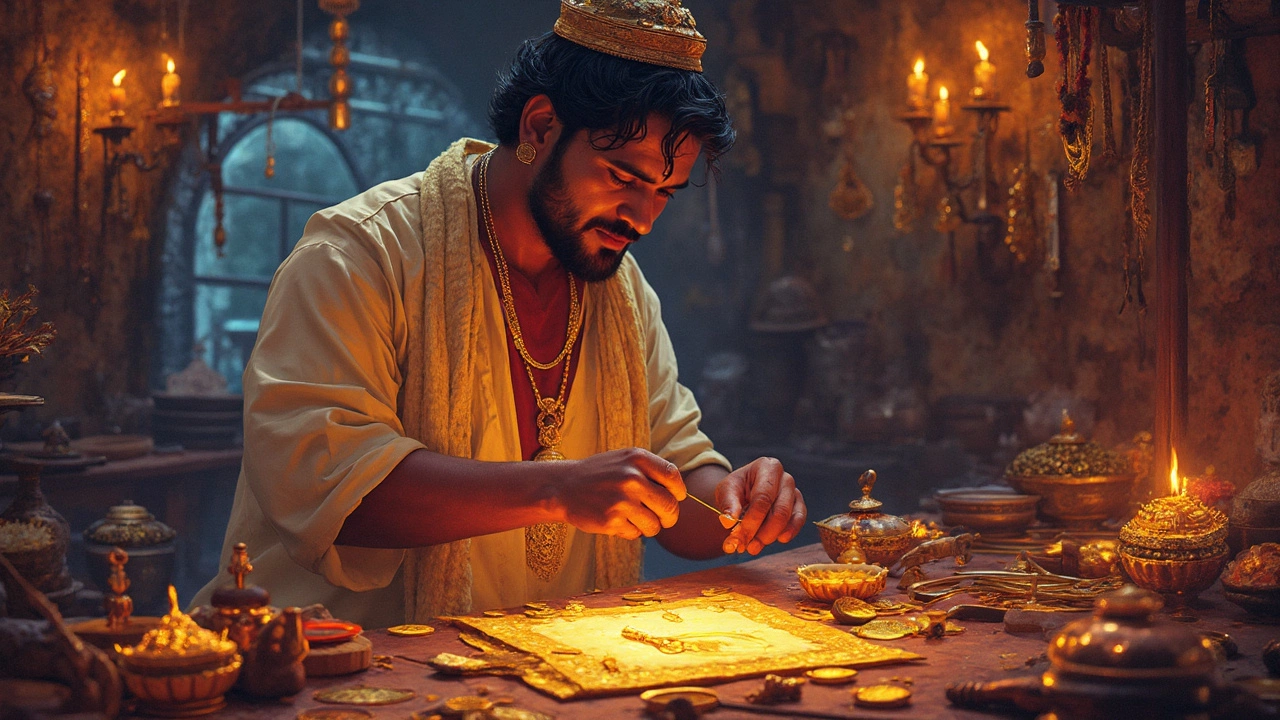Nagas gold isn’t just about decorative embellishments; it's a rich representation of Indian tradition and artistry, often found in temple jewelry. Originally, these ornate pieces adorned deities in South Indian temples, but today, they highlight cultural events, religious ceremonies, and even everyday wear for some. But what makes Nagas gold stand out? Let's journey into the basic essence of this fascinating craft.
One of the most captivating aspects of Nagas gold is its unique design, usually intricate and deeply symbolic. Crafted by expert artisans, these jewels often feature motifs inspired by mythology, nature, and spirituality. Think of dazzling peacocks, sacred elephants, and divine gods — each holding a story, every design breathing history. But it’s not all about looks; these pieces also carry deep cultural resonance, echoing tales passed through generations.
- Origins of Nagas Gold
- Design and Craftsmanship
- Cultural Significance
- Spotting Authentic Pieces
- Caring for Nagas Jewelry
- Modern Trends and Usage
Origins of Nagas Gold
The history of Nagas gold begins in the lavish courts and divine temples of ancient India, particularly in the southern states. These areas, known for their rich cultural heritage, were pioneers in crafting what we now admire as temple jewelry. But where did it all start? Exploring its roots takes us to the time when kings and priests sought elaborate adornments to place upon idols and during sacred ceremonies.
The Early Inspirations
Traditional temple jewelry was revered not just for its beauty but for its symbolism. Every piece was crafted to honor the gods, with designs inspired by mythology and nature, meant to invoke blessings and prosperity. The artisans behind these pieces believed in creating what was not just jewelry, but an offering.Craftsmanship Techniques
Creating temple jewelry required meticulous skill. Artisans used age-old techniques, carefully handing down their craft through generations. The gold was shaped and molded with incredible precision, ensuring longevity and luster. Even today, this tradition continues, with few selecting the rare craft of Nagas craftsmanship as their profession.Role in Historical Events
Throughout history, Nagas gold played a crucial role in cultural and religious activities. It symbolized prosperity and divine favor, making it the centerpiece of major celebrations and rituals. Regular folks often associated these jewels with high esteem, recognizing them as symbols of status and devotion.Understanding the origins of Nagas gold offers a window into India's illustrious past, blending artistry with spirituality. As time goes on, the traditional methods keep this art form alive, continuing to capture the admiration it enjoyed centuries ago.
Design and Craftsmanship
When it comes to Nagas gold, the first thing that captures your attention is its intricate design and the skillful craftsmanship that goes into each piece. This jewelry is hand-crafted, predominantly in southern India, where artisans pass down their secrets through generations, ensuring each item reflects a legacy of expertise.
The Art of Crafting
Every piece of temple jewelry India speaks to the time-honored techniques that have been perfected over centuries. Artisans often use age-old methods, starting with a base metal framework which is then generously coated in gold, giving it that signature gleam and durability. This process not only ensures longevity but also highlights the artwork's intricate details.
Distinctive Design Elements
Designs carry rich symbolism—peacocks for beauty, lotus blossoms for purity, and deities for divine protection. These motifs are not just decorative; they're etched to evoke cultural narratives and spiritual themes. Often, these designs are paired with vibrant, colorful precious stones like rubies and emeralds, adding a pop of color that enhances the gold's luster.
The unique blend of artistry and emotional engagement in Nagas craftsmanship makes these pieces real conversation starters. Whether it’s the detailed designs of gods and goddesses or the deliberate curves and flourishes, each detail is curated to convey a specific meaning or tell a story.
Understanding the Making Process
- Design Sketching: Initial designs are drawn, capturing the essence of the traditional motifs and desired themes.
- Metalwork: The core framework is crafted using traditional tools, ensuring the structure is both solid and aesthetically pleasing.
- Engraving: Artisans meticulously carve out the designs, bringing every line and shape into relief.
- Stone Setting: Precious stones are carefully set, chosen not just for color but for their symbolism and significance within Hindu beliefs.
- Gold Coating: Finally, the piece gets its gold polish, adding the iconic sparkle that makes Nagas gold so coveted.
The dedication and patience required to produce each jewelry piece are remarkable, turning simple materials into exquisite art. If you're curious about how this type of jewelry remains a significant element of cultural identity, keep an eye out for the intricate designs mixed with cultural affinity, which is what makes these pieces enduring masterpieces.
Cultural Significance
The cultural significance of Nagas gold runs deep in the history of Indian traditions, particularly in temple rituals and ceremonies. This jewelry isn't just ornamental; it embodies the spiritual beliefs and artistic expressions of ancient Indian society. Often used to adorn the idols of deities, Nagas gold pieces are considered offerings, endowed with the auspiciousness believed to bring blessings.
Temples across South India, especially in Tamil Nadu and Kerala, are renowned for their elaborate collection of temple jewelry. These pieces are intricately designed to portray figures from Hindu mythology, like Lord Krishna and Devi, symbolizing their divine presence. Women dancers of Bharatanatyam, the classical dance form of South India, traditionally wear Nagas gold during performances to invoke the grace and charisma of these celestial beings.
A quote by renowned historian Dr. Radhika Pillai vividly underscores this:
"The intricate designs of Nagas gold bridge the mortal and the divine, acting as a vessel for spiritual stories and cultural heritage."
The reverence for these crafts transcends religious practices, blending into familial and public ceremonies. During weddings, for instance, embellishments in temple jewelry form part of the bridal trousseau, embodying both beauty and tradition. Families often pass down these pieces as heirlooms, further rooting their significance in cultural continuity.
Women and Nagas Gold
In many families, women inherit Nagas gold as a testament to their lineage and history. It's not just about its beauty; every piece also represents a family's identity and legacy, often cherished for generations. For many, these treasures hold more than sentimental value—they're seen as a link to divine protection and prosperity.
Through understanding the cultural significance of Nagas gold, one gains a deeper appreciation for its timeless allure and the history it carries, bridging the gap between ancient beliefs and modern artistry.

Spotting Authentic Pieces
When you're out looking for genuine Nagas gold jewelry, a keen eye can make all the difference. With imitations flooding the market, knowing what to look for can save you a lot of headaches—and money! Here's how you can tell if you're looking at the real deal.
Check the Craftsmanship
Authentic Nagas gold is crafted with precision and intricacy. Examine the details closely; real pieces will have refined edges and symmetrical shapes. The motifs like peacocks, elephants, and deities should be well-defined. If they look rushed or uneven, it might not be the genuine article.
Weight and Texture
Nagas gold jewelry tends to be heavier because it uses a higher percentage of gold. Feel the weight in your hand; authentic pieces generally feel substantial. The texture should also be smooth and consistent, a hallmark of careful, skilled work.
Look for Hallmarks
Authentic pieces usually carry hallmarks that indicate purity—look for stamps indicating the gold's karat or purity level. Most genuine pieces will have a '916' stamp, signaling 22-karat gold, which is the standard for traditional Indian jewelry.
Provenance and Certification
Whenever possible, buy from reputable jewelers who can provide certification of authenticity. This certification should include details like the type of stones used, the gold's purity, and even the artisan if it's part of a distinctive collection.
- Verifiable seller reputation
- Availability of authenticity certificate
- Recognition of traditional motifs
Insider Tips
Talk to locals or those in the know if you're buying while traveling in India. Sometimes, seasoned advice can help you avoid scams. Also, always compare similar pieces to get a feel for standard characteristics.
Caring for Nagas Jewelry
Taking care of your Nagas gold is what keeps it stunning through the decades. These pieces are more than just jewelry — they're a treasure trove of tradition and art. Here's how to ensure they shine bright for years to come.
Cleaning and Polishing
Regular cleaning is key. Use a soft cloth, gently wiping each piece to remove dirt and oils from regular wear. Remember, harsh chemicals are a big no-no since they can tarnish the gold and damage the intricate designs.
- Make a mild cleaning solution with lukewarm water and a dash of gentle soap.
- Dip a soft-bristled toothbrush into the solution, lightly scrubbing the jewelry to reach into those detailed carvings.
- Rinse with clean water and pat dry with a soft towel.
Storage Solutions
Proper storage prevents those dreaded scratches and keeps the intricate craftsmanship intact. Always store Nagas jewelry in individual cloth pouches or a lined jewelry box. To keep moisture at bay, consider placing silica gel packets in your jewelry box.
Handling with Care
When putting on your temple jewelry India pieces, it's best to wait until after any perfumes or lotions have been applied. These substances can rob your jewelry of its luster.
Getting Repairs Done
If your Nagas gold shows signs of wear or damage, don't try DIY fixes. Instead, take it to a skilled jeweler who understands the delicate artistry. Regular check-ups can help keep any issues from becoming serious problems.
With these care tips, your beloved Nagas gold can remain as brilliant and captivating as the day you first laid eyes on it.
Modern Trends and Usage
The charm of Nagas gold hasn't just stuck to tradition; it's gracefully evolved into modern fashion trends. While it continues to hold a sacred spot in religious and cultural festivities, today's designers are fusing it with contemporary styles to capture global attention. So, how's this historic beauty making waves across trendy wardrobes?
Fusion of Tradition and Fashion
These days, you'll spot Nagas gold in more casual and varied settings. Designers blend these traditional motifs with modern styles, like minimalist chains or even urban wear, carving a niche that's both retro and on-trend. This fusion attracts younger audiences who appreciate both cultural roots and modern aesthetics. It's not uncommon to see brides choosing Nagas pieces over conventional diamond sets, embracing a blend of old and new.
Celebrity Endorsements
Catch a glimpse of Bollywood's red carpet, and you're bound to spot Nagas-inspired jewelry adorning celebrities. This high-profile use catapulted its popularity beyond boundaries. Actresses might pair a dazzling temple necklace with elegant sarees or even simpler western outfits, proving its versatile allure.
Customization and Personalized Gifting
The rising trend of personalized gifting brings Nagas jewelry into the limelight. Shoppers often seek out custom pieces that incorporate family motifs or unique symbols, turning these jewels into personalized heirlooms. Many jewelers offer bespoke services, allowing customers to add a touch of preference and sentiment to their pieces.
Sustainability and Ethical Jewelry
In an era where sustainability matters, ethical crafting practices of Nagas gold gain importance. Artisans focus on using environmentally-friendly methods and fair labor, which appeals to the growing eco-conscious crowd. Supporting such craftsmanship not only provides unique jewelry but also promotes ethical consumerism.
Nagas gold proves that tradition can walk hand in hand with modernity, making it relevant and appeal across generations. It's a treasure that continues to be cherished, whether it’s worn proudly in a temple celebration or a glamorous fashion event.



